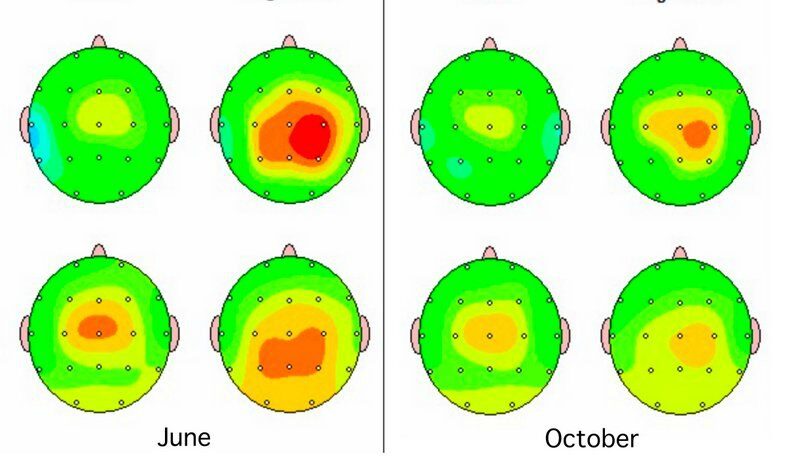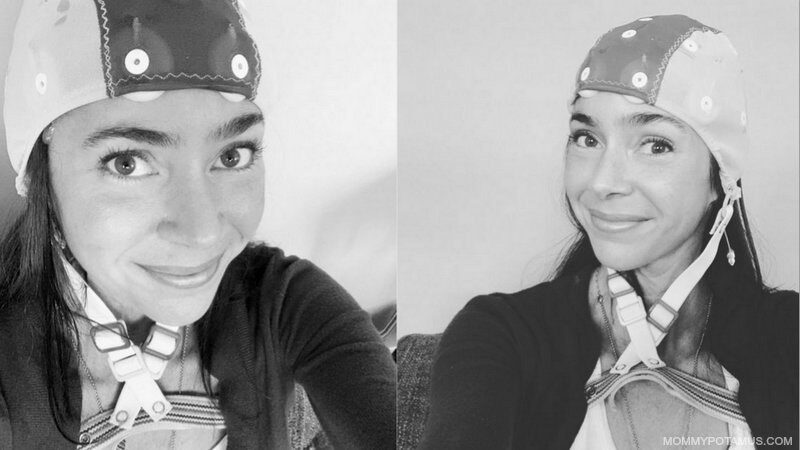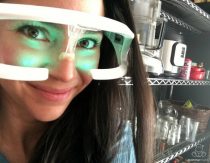
What if you could enhance your cognitive and emotional resources by playing a video game? Or maybe train your brain to sleep more deeply? According to this article from Harvard University, a form of brain training called neurofeedback may be able to get “our brains to act in desirable ways” by providing personalized feedback in real-time.
When I first called Dr. Andrew Hill – a UCLA-trained cognitive neuroscientist – to learn about neurofeedback therapy, I envisioned some sort of monotonous and tedious procedure about as interesting as watching paint dry. I certainly wasn’t expecting dragons and spaceships, yet weeks later as I settled into a comfy chair at Peak Brain Institute, I found myself ready to glide through the air . . . with my mind.
- So, what is neurofeedback therapy?
- Getting a Neurofeedback Assessment (qEEG Brain Mapping)
- Benefits of Neurofeedback Therapy
- Attention, Focus & Memory
- Stress Relief & Overall Well-Being
- Creativity & Performance
- Sleep Quality
- Does neurofeedback have any side effects?
- My Experience With Neurofeedback Training
- Choosing a Neurofeedback Practitioner
Using little electrodes secured to my scalp, a machine picked up my brainwaves. As my mind shifted toward a relaxed, focused state I was able to fly the spaceship (or dragon) on the screen . . . and when it shifted away I lost control, or crashed into a wall, or watched the screen go dark.
My brain didn’t like that, so it shifted back to relaxed focus, and the longer it stayed in that mode the easier it became to maintain a peaceful, productive state . . . not just while I’m brain training, but in my actual day-to-day life.
A few months later I returned for a follow-up qEEG brain map, which confirmed what I already knew. Compared with the first qEEG taken a few months before, I am getting better quality sleep and have much more mental resilience/less fatigue.
For me, this is more than just a nice upgrade – like switching from iceberg lettuce to kale. When I was diagnosed with Lyme disease and began my healing journey, it was filled with challenges and setbacks. A big one was a decline in both sleep quality and quantity, which is not all that surprising since Lyme is known for its negative impact on sleep. (1)
Also, a “hot spot” commonly associated with trauma (also common with Lyme disease) calmed down significantly, which I’ll share more about later in this article. The image below shows both of my scans from June and October.

Of course, people seek neurofeedback for many different reasons, including help with:
- Mood
- Attention and productivity
- Self-regulation
- Energy
- Feelings of anxiousness
- Improving stress resilience
- Sleep
We’ll dive deeper into the benefits of neurofeedback soon, but first I want to mention that none of these statements have been evaluated by the FDA, this article is not medical advice, and it is not meant to diagnose or treat any condition. As always, please talk with your healthcare provider about any therapies you are considering.
So, what is neurofeedback therapy? ^
We’ve all heard of neuroplasticity – or the brain’s ability to change itself in response to its environment – but what does that really mean? One fascinating example I came across recently is this study. When participants were blindfolded for five days, their visual cortex rewired itself to process sound and touch. Pretty amazing, right? Even more interesting is the fact that after the blindfold was removed, their brains adapted to that change, too.
Of course, walking around blindfolded for five days so that you can temporarily process sounds and touch better is probably not a life goal, but our brains capable of adapting in a lot of ways that can benefit our daily experience of life. We can change our brains with mindfulness, gratitude and many other practices – all of which I use – but neurofeedback is considered one of the fastest and most powerful ways. (And that has been true in my experience.
How Neurofeedback Works
Right now as you’re reading this, there are billions of neurons in your brain firing electrical signals. These pulses create wave-like patterns that move at different speed and can be measured with external sensors. We call them brainwaves.
Specifically, there are five types of brain waves that we can measure: alpha, beta, gamma, delta, and theta.
Neurofeedback uses sensors to see what the brain is producing in real-time, then it uses a reward system to help guide the brain toward a more optimal brainwave pattern. In my case, when my brainwaves are in the desired range I’m able to fly the dragon or spaceship on my screen, and when my brain tries to revert to old pathways I crash or miss my target.
In other words, the game tells you immediately when your brain approaches your desired state. And while that’s nice, the best part is that the benefits extend far beyond that moment.
As neuropsychologist Donald Hebb once wrote, “Neurons that fire together, wire together,” which means that the more often a brain achieves a certain state, the stronger that neural network becomes, making the process more efficient and easier over time. Just like with physical exercise, the more your brain practices achieving a balanced, comfortable, efficient state, the better it gets at finding that sweet spot in day-to-day life.

Getting a Neurofeedback Assessment (qEEG Brain Mapping) ^
Of course, figuring out what to target with brain training depends on what kind of brain patterns are unique to you. That’s why the first step in starting neurofeedback is to get a qEEG brain map. If you’ve never heard of it before, Quantitative Electroencephalography (qEEG or Quantitative EEG) brain mapping is an assessment tool that uses electrodes to measure brainwave activity.
That’s why the first step in starting neurofeedback is to get a qEEG brain map. If you’ve never heard of it before, Quantitative Electroencephalography (qEEG or Quantitative EEG) brain mapping is an assessment tool that uses electrodes to measure brainwave activity.
Here’s how it’s done: You sit down in a chair and get comfy. Your EEG technician puts a cap on you with wire electrodes threaded throughout. You think this might be a good time to take a selfie, then you flip the camera on and realize that you look like a cross between a 1930s aviator and a clown. You snap the photo anyway.
Next, the technician squeezes conductive jelly on the electrodes and you sit for 10-20 minutes while your brainwaves are recorded. The results are shown via a visual map that compares your brain to healthy individuals that are similar to you (same sex, age range, etc.).
Some areas may look “hot,” or overactive compared to most people, while others may appear underactive. According to Dr. Hill, not every variation from normal is a problem. However, they often do indicate areas that could be pain points.
Benefits of Neurofeedback Therapy ^
Neurofeedback is not FDA-approved to treat any specific condition or disorder, but it is used in both clinical and wellness settings to optimize overall brain function. It is approved by the FDA for stress relief, which users often report significantly improves overall quality of life.
In addition, the American Academy of Pediatrics rates biofeedback (the parent term for neurofeedback) as a Level 1 “best support” option for ADD/ADHD. (2) With that in mind, here are some of the top benefits of neurofeedback.
Attention, Focus & Memory ^
In this study, healthy adults used neurofeedback to achieve two different states associated with executive function: theta (working memory) and SMR (often described as relaxed focus). After eight sessions they were able to selectively increase their SMR activity and “exhibited a significant and clear improvement in cued recall performance” and to a lesser extent focused attention.
The participants did not show the same ability to selectively increase theta brainwaves. However, many practitioners say that eight sessions is not sufficient to achieve certain types of optimization.
Also, although it is not considered a treatment or cure for ADD/ADHD, according to Harvard Medical School:
Children diagnosed with ADHD tend to have an excess of low frequency (theta) brain waves and fewer high frequency (beta) waves in certain regions of the cortex, as detected by EEG (Figure 2). Therefore, neurofeedback training for children with ADHD attempts to minimize the occurrence of lower frequency theta waves and enhance the occurrence of higher frequency beta waves. This is done by rewarding the children each time they demonstrate beta waves during neurofeedback training. Through the process of operant conditioning, the children intuitively learn to promote beta waves and suppress theta waves (Figure 2).” (3)
Stress Relief & Overall Well-Being ^
Neurofeedback is FDA-approved for stress relief. Some studies have also found that it may contribute to an overall increase in well-being. For example, in this study, participants who received neurofeedback training designed to enhance alpha brainwaves felt fewer negative emotions, including anxiousness.
Creativity & Performance ^
In two studies done with musicians, dancers, and singers, alpha and theta brain wave training improved overall performance. (4) (5]
In children, alpha/theta training showed benefits in both creativity (specifically measured with respect to musical performance) and an overall sense of well-being. (6)
Sleep Quality ^
One fascinating aspect of brain training is that achieving a particular brainwave pattern can have seemingly opposite benefits. For example, SMR training is associated with increased working memory and focused attention, but it’s also associated with better sleep.
In this study, healthy individuals who learned to increase the sensorimotor rhythm (SMR) brainwave through neurofeedback were able to fall asleep faster and sleep more deeply than controls.
Does neurofeedback have any side effects? ^
According to Neurofeedback and Neuromodulation Techniques and Applications, “Neurofeedback is a non-invasive treatment with no known significant or lasting negative side effects.” With that said, just like working out can cause sore muscles, neurofeedback can cause mental fatigue and other temporary side effects such as vivid dreams and irritability.
I have personally experienced mild effects like mental fatigue (sometimes with a burst of energy a couple of hours later) and feeling spacey from time-to-time. When that happens I let Dr. Hill know and we adjust my protocol to get me back where I want to be.
My Experience With Neurofeedback Training ^
Although it’s possible to get a qEEG without a doctor’s order, I was introduced to brain mapping when my M.D. requested that I have it done. My first qEEG was performed by a neurologist, but because his office forgot to tell me to skip coffee before my test the results weren’t valid.
I thought about going back for a re-test, but in order to complete neurofeedback sessions through the neurologist I’d need to drive 3 hours daily for 40 days. That didn’t even include the actual treatment time, and I wasn’t sure I could pull it off logistically.
That said, what worked for my husband in his Lyme recovery wasn’t working for me, and with the encouragement of my M.D. I felt like this was something I needed to pursue. So when when a friend told me that UCLA-trained cognitive neuroscientist Dr. Andrew Hill – founder of Peak Brain Institute – works with clients both in the office and in home settings, I decided to schedule a free consult.
After talking with him and a few other organizations, I decided to buy the equipment needed to do neurofeedback at home and work with Dr. Hill remotely. It was big investment – and not one I took lightly – but now I own the equipment and I can do as many sessions as I want for as long as I want. (Also, my husband is using it, too.)
Before we started brain training, my husband and I traveled to one of the Peak Brain offices for a three-day intensive. We learned how to use the equipment and played games to get familiar with the process. I wasn’t expecting much from our training other than technical instruction, but by the time we drove home from our intensive I was already sleeping better than I had in months.
At home, we message (often in real-time) with Dr. Hill and our neuofeedback coordinator, Jon, about the challenges we’re facing from day-to-day. They adjust our training protocols as needed.
Here are some things I’ve noticed over the past few months:
Better Sleep
My first brain map showed that I wasn’t making many delta waves, which are needed for deep, healing sleep. Although frustrating, this felt validating in a way. I was using all the sleep hacks I knew of, yet I was still waking up tired. Lyme is notorious for eroding sleep quality, and I was able to see firsthand the impact it was having on me. (1)
As I mentioned above, within days of starting neurofeedback I found I was falling asleep easier, staying asleep longer, and waking up more rested. Then a couple of months later I discovered weighted blankets, which made things even better. Neurofeedback works with the central nervous system, while other modalities such as weighted blankets work more on the peripheral nervous system, so the two can be complementary.
Improved Well-Being
My initial qEEG also showed increased activity in areas associated with trauma, which is not surprising given that the symptoms of traumatic brain injury (TBI) and Lyme disease can be similar in presentation. (7) I’ve also experienced traumatic events, like the loss of my dad when I was very young, which likely contributed.
In my follow-up qEEG the “hot spot” had faded significantly. I still have a ways to go, but I’m encouraged by my progress so far.
Focus, Attention & Working Memory
My husband and I like to take daily walks and talk about . . . well, everything, and for awhile it became a running joke that I could reference a relevant study no matter what subject we land on. However, during the hardest part of my recovery I struggled a lot with focus, attention and working memory. Maybe it was due to the lack of quality sleep or “Lyme brain,” as some people describe the feeling of brain fog that is common with Lyme.
Either way, my follow-up attention test showed significant gains in both auditory and visual focus, and my husband is back to teasing me about my random study references on our walks.
Choosing a Neurofeedback Practitioner ^
Brain training requires commitment and consistency, and it’s important to work with someone who truly understands the process and can tailor it to your needs. Also, unlike sunshine and exercise – which are free – it is a significant investment.
With that in mind, here are some questions to ask local offices if you’re considering neurofeedback:
- Do you use qEEG brain mapping?
- Is your approach tailored to the individual or a one-size-fits-all approach?
If you live near one of Dr. Hill’s offices in Costa Mesa, Culver City, or St. Louis (more locations coming), I highly recommended giving them a call, or if you want to learn about working with them remotely you can visit their website.
Also, if you’d like learn more about the benefits of neurofeedback, the Peak Brain Institute website has an excellent section with current research.
Have a question about neurofeedback therapy? Please leave it in the comments below!
Sources:
- Weinstein, ER et. al. (2018) Sleep Quality In Well-Defined Lyme Disease
- American Academy of Pediatrics. Evidence-Based Child and Adolescent Psychosocial Interventions.
- Asher, Tedi (2017) Brain training: The future of psychiatric treatment?
- Egner, T and Gruzelier, JH (2003) Ecological validity of neurofeedback: modulation of slow wave EEG enhances musical performance
- Raymond, J et. al. (2005) Biofeedback and dance performance: a preliminary investigation.
- Gruzier, JH et. al. (2014) Beneficial outcome from EEG-neurofeedback on creative music performance, attention and well-being in children
- Azzolino, Sergio and Carrick, Frederick (2018) The prevalence of Lyme disease and associated coinfections in people with persistent post concussive syndrome




